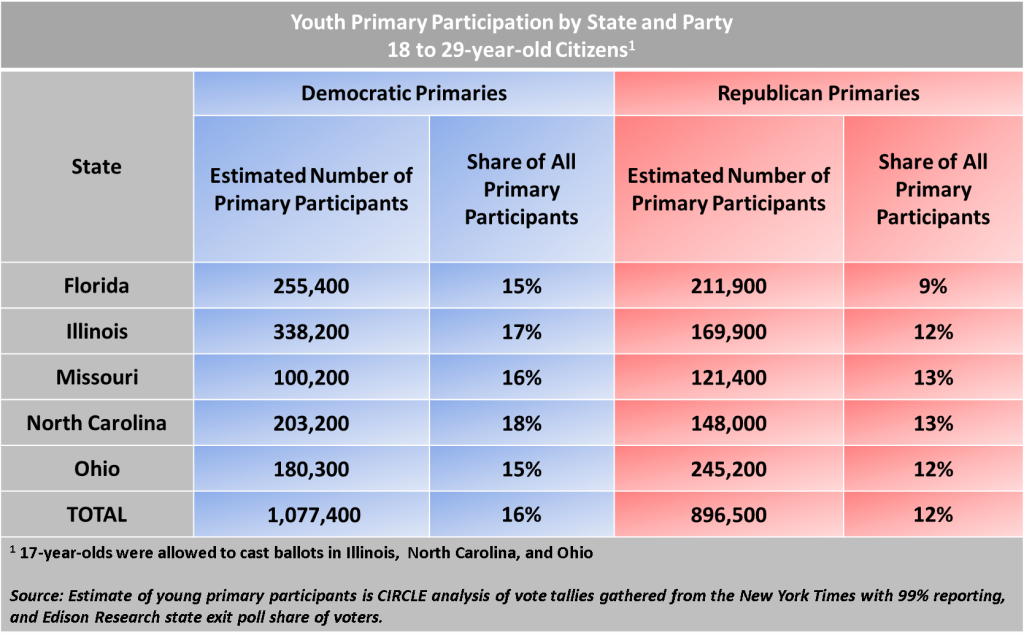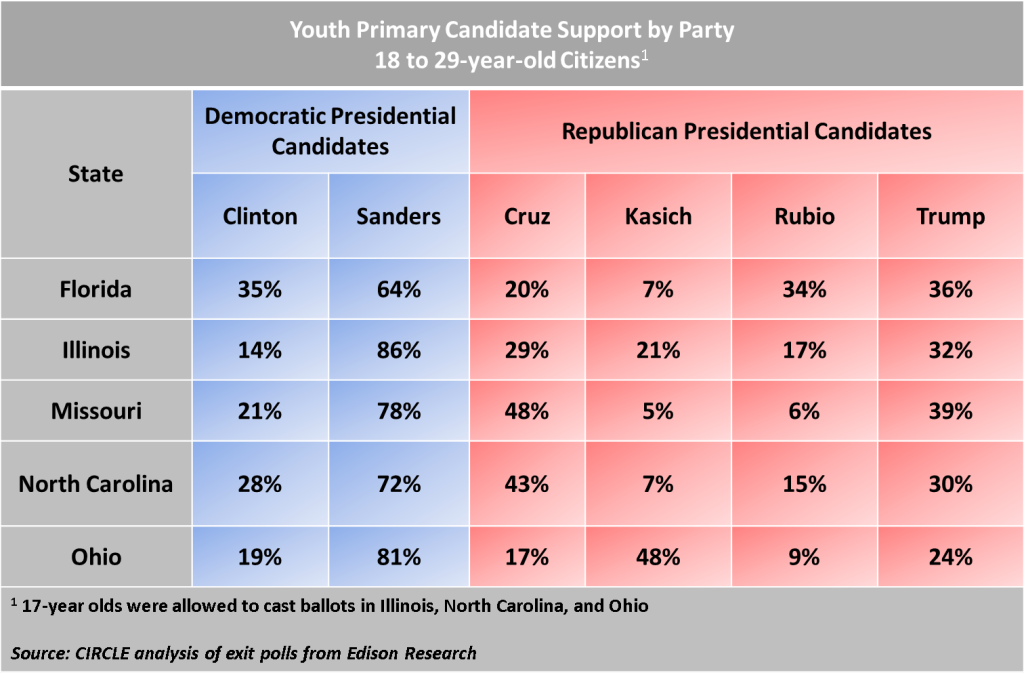Record-Breaking Youth Turnout Continues; Clinton and Trump Still Lagging with Young Voters
Note: This post has been updated with newer turnout and exit poll data.
Young people continued to make their mark on this primary season during the all-important March 15 contests, breaking the previous youth turnout records (set in 2008) in every state except Ohio, often by substantial margins. Youth also had an impact by choosing differently than older voters. They preferred Senator Sanders in all five states. On the Republican side, they chose three different candidates: Senator Cruz in Missouri and North Carolina, Governor Kasich in Ohio, and Donald Trump in Florida and Illinois. The frontrunners have yet to decisively win over youth this election season.
While data is important for understanding youth participation on this “second Super Tuesday,” views from the ground are also critical. CIRCLE gathered several reflections from practitioners working with youth that provide insight into education and outreach efforts by educators, media, and nonprofits.
Youth Turnout Records Continue to Build, As Does Participation in Republican Primaries
Youth turnout was high across the board on Tuesday, surpassing previous records by 6 or more percentage points—a large increase—in Illinois, Missouri, and North Carolina. While turnout appears to be high across all age groups this primary season, the increase in youth participation has been especially notable. Young voters made up a larger share of all voters than in 2008 in Florida, Illinois, and North Carolina, and equaled the previous mark in Missouri. Ohio was the only state where youth participation, both in terms of turnout and share of all voters, actually went down.
On the Democratic side, the number of youth who voted in the primaries went up significantly in Florida and Illinois since 2008, but went down in Missouri, North Carolina, and Ohio. On the other hand, in every state for which we have data[1] more youth than ever cast ballots in the Republican primaries. The increase was very large in all cases; the number of young Republican primary voters surpassed previous records by at least 45,000 in Missouri and by over 113,000 in Ohio over the previous record.
More state-by-state information below:
Florida
An estimated half a million votes were cast by young Floridians this year, who nearly doubled their participation from 2008. In the Democratic primary, almost two-thirds of youth supported Senator Sanders, while all other age groups supported Secretary Clinton by a 2 to 1 margin or greater. In the Republican primary, youth cast a plurality of their votes for Donald Trump (36%), but their support was much weaker than that of the general electorate, almost of half of whom supported him (46%).
CIRCLE has ranked Florida (along with North Carolina, Ohio and Illinois) high in our Youth Electoral Significance Index of where young people are likely to have a disproportionate impact on 2016 election results.
Illinois
In a state where young people led heated protests against Donald Trump days before the election, and where the ballot featured contested races for Attorney General and other key state and local positions, Illinois youth had tremendous participation levels in both primaries with an overall turnout of 26%, well above the previous record of 18% in 2008.
Young Republicans split their votes fairly evenly between all four remaining candidates. Although Mr. Trump won the youth vote by a narrow margin (32%, with Cruz a close second at 29%), as in Florida, he received less support from youth that from voters aged 45 and older. Democratic youth participated in a number that far exceeds their participation in 2008 when youth supported Barack Obama, then a sitting Senator in Illinois, over Secretary Clinton, who was born in the state. This time, 86% of youth supported Sanders, a Senator from Vermont. Their votes no doubt kept the Democratic primary in Illinois close.
Missouri
Missouri youth had a strong showing in the Republican primary, and young voters made a strong statement by choosing Senator Cruz well above Trump, 48% to 39%. In the Democratic primary, Sanders once again received overwhelming youth support: 78%. The youth vote in both parties certainly kept each contest extremely close; as of the morning after the primary, both races were too close to call.
North Carolina
In North Carolina, almost three-quarters (72%) of Democratic youth supported Sanders, which may indicate that his appeal among youth in more diverse Southern states may be improving. Other age groups overwhelmingly voted for Secretary Clinton, however, leading to her decisive victory there. On the Republican side, youth gave the most decisive support for Senator Cruz at 43%, While Trump received 30%.
Ohio
Young Republicans in Ohio turned out in a large numbers, leading to greater participation in that party’s primary than on the Democratic side. As with older voters, young Republicans’ top pick was Ohio Governor Kasich, who won 48% of the youth vote, followed by Donald Trump, who won just 24% of young voters. Ohioan youth supported Senator Sanders 81% to 19%, but their turnout was well below that of 2008, and their impact was limited in this primary race.
It is worth nothing that the Ohio Secretary of State’s Office issued a letter to 17-year-olds who were eligible to vote in the primaries in the past (because they would be 18 by the date of general election), stating that they would not be able to vote in this year’s primary. Although the judge eventually ruled that these 17-year-olds can vote in Ohio’s open primaries, the confusion over eligibility may have affected the turnout among 17-year-olds. In fact, Ohio was the only one among the March 15 primary states where the participation declined since 2008.
The results from this latest and critical round of primaries continue to demonstrate that young people are active, and ideologically diverse and complex. Particularly striking has been this year’s trend of high participation among young Republicans; for example, though in 2008 the number of young voters in the Missouri and Ohio Democratic primaries was higher than in the Republican primaries in this year, greater numbers of youth in those states voted in the Republican primaries than in the Democratic primaries. These figures are not indicative of how young people will vote in the general election but they do show young Republicans’ sense of urgency to participate in order to voice their opinions.
For regular updates in your Inbox about youth and the 2016 election,
sign up for CIRCLE’s monthly E-Update here.
—
[1] We do not have any historical Republican youth primary participation data in North Carolina.









